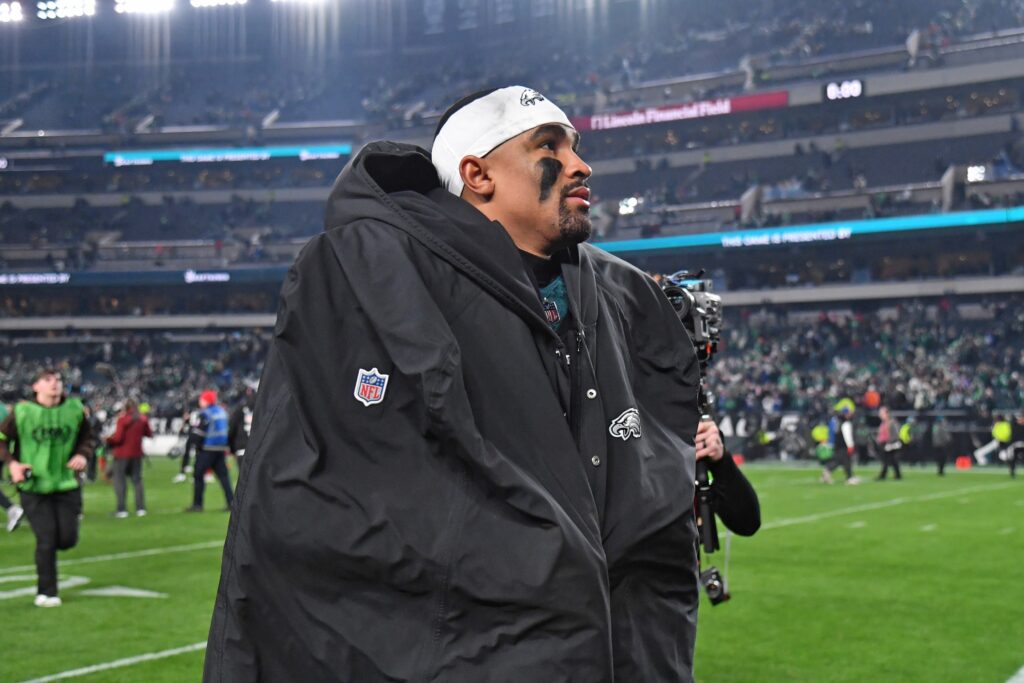Ad Disclosure
This Inquirer Story on Eagles Crowd Noise is the Perfect Contemporary Sports Media Case Study

Marcus Hayes wrote an opinion piece for the Inquirer titled “Eagles to fans at the Linc: Shut up (when we’re on offense).” It’s about crowd noise affecting the offense and their ability to hear themselves and work off a cadence at the line of scrimmage.
The story is pretty straightforward. Marcus has quotes from Jalen Hurts, Jason Kelce, Jordan Mailata, Landon Dickerson, and Nick Sirianni. Some are from the podium and other quotes are from the locker room.
Here’s a sampling of what’s behind the paywall:
Left tackle Jordan Mailata insisted that neither of his two false starts at home was precipitated by fan noise, but, when asked if he’d like less racket when trying to hear a play call, he replied:
“One hundred percent. I would love to hear the cadence,” Mailata told me Wednesday. He doesn’t like silent counts on the road, and he hates when the Eagles have to use silent counts at home. “People don’t understand the gravity of playing at home. Because we can go on our cadence. Maybe draw them offside.”
Mailata said the Eagles use a silent count at home “a fair bit.” Again, that included the “Run the Ball!” drive Monday. Mailata said he didn’t know what the fans were chanting, only that the chants made it hard to hear.
“I promise you, I had no idea what they were saying. They were just loud,” Mailata said. “I was trying to just lock in, not get any more false starts.”
Looking at the response on social media, fan reaction is exactly what you’d think it is. “This is absolutely ridiculous. Can our own media stop trying to pit the fanbase against the players? This is insulting,” wrote one person. “Ahh so now it’s Marcus Hayes and Jeff McClane (sic) both working together to try and sabotage the team,” said another.
Taking that into account, I’ve identified seven paths of action that fans might take when seeing this story hit their feed:
- they hate the premise and keep scrolling
- they hate the premise, but comment without reading
- they won’t read anything Marcus writes as a general principal
- they might be curious, but won’t pay for an Inquirer subscription
- they accuse the media of making shit up even though multiple players and a coach are quoted in the story
- they read the story but think it’s a stretch (or blame the Eagles for making up excuses)
- they read the story and agree
- (edit – I’ll add an 8th here, because I see people saying that Christmas night features a lot of casual fans who seemingly shout and yell randomly)
It’s fascinating to look at from afar, because there’s a general backlash simply to the broaching of subjects that fans don’t like or don’t want to read about. McLane’s recent report about “internal concern” with Jalen Hurts was panned by a portion of folks who just don’t want to hear anonymous sources talk about QB1 when the team is 10-4 (at the time). “Not now,” is essentially what they’re saying. Similar thing with Mike Sielski writing about Brock Purdy, which was really a standard article featuring one sentence that could have been reworked. Pagan’s take was that he simply did not want to read about the opposing quarterback. And then with Marcus, he’s getting into a topic that some people just aren’t into right now.
One thing I’ve noticed is that there’s just more of a general anti-media sentiment these days. This podcast host and basketball guy on Twitter, Josh Reynolds, has a famous line in which he says “Nobody hates Philadelphia athletes more than Philadelphia media, and nobody hates Philadelphia media more than Philadelphia fans.” That makes me laugh when I see it, because it’s an oversimplification, but his tweets also get a ton of likes, so he’s not just throwing some catch phrase out there. There’s a large portion of Philly sports fans who just don’t like the media and don’t value anything the media does. They get their content on social, or from player podcasts or YouTubers or other independent outlets. The landscape is vastly different than it was just 10 years ago, and they’re going to age into the key demographic that advertisers look for, so we’d all be smart to listen to what they have to say and study their consumption of sports media, instead of just dismissing them as pom-pom waving fan boys. Call them “fans,” sure, but they’re also customers, and some would say that the customer is always right, even if they want their steak well done.
It’s also worth pointing out that the younger demo is more active and vocal on social media, so you might see their responses and reactions more frequently. I am sure there’s an older portion of Inquirer readers or traditional news consumers who feel differently about those products. That’s something that’s hard to analyze and parse.
Still, you could take this particular piece, bring it to a college classroom, and analyze everything about it. It’s a perfect case study for 2023 sports writing. Do fans believe this shit? Do they even want to read it? Do they trust the author and the outlet? Do we need to write more about what customers want to hear, vs. what we think they need to hear?
All valid questions! I am fascinated with this stuff, as you can tell. It’s an interesting time in sports media. We’re at a content crossroads.
#Eagles players to fans:
STFU!
🤦🏽♂️https://t.co/ns20Ps1btD— Marcus Hayes (@inkstainedretch) December 28, 2023
Kevin has been writing about Philadelphia sports since 2009. He spent seven years in the CBS 3 sports department and started with the Union during the team's 2010 inaugural season. He went to the academic powerhouses of Boyertown High School and West Virginia University. email - k.kinkead@sportradar.com